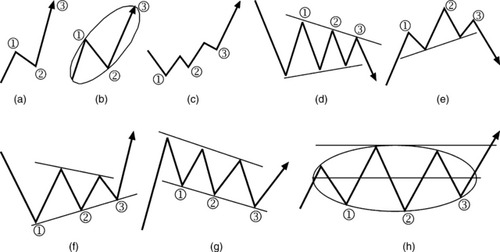3-POINT CHART PATTERNS
It is amazing how often the number 3 is found in chart patterns and many technical approaches. Elliott's wave principle includes three impulse waves in three major phases (major, secondary, and minor); there are three trend directions (up, down, and sideways); and there are three most important indicators for traders (price, volume, and open interest).
The number 3 is important in chart patterns such as these:
- Head-and-shoulder formation
- Rectangle, flag, wimple, wedge
- Triple top or bottom
- Symmetrical, ascending, or descending triangle
- Three rising valleys or three falling peaks
- Morning star or evening star candlestick
Ideal Types of 3-Point Chart Patterns
This analysis will concentrate mainly on 3-point chart patterns to be found in the following:
- Trend channels
- Trend lines
- PHI-ellipses
Three-point chart formations can easily be handled after being detected on price charts. The biggest advantage of this approach is that most investors can identify chart patterns and execute corresponding trading strategies with or without the aid of a computer.
Figure 3.35 illustrates some of the basic 3-point wave patterns.
FIGURE 3.35 Basic Chart Pattern Formations Including the Magic Number 3
Source: Robert Fischer and Jens Fischer, Candlesticks, Fibonacci, and Chart Pattern Trading Tools, John Wiley & Sons (2003), p. 8.

Application of 3-Point Chart Patterns
The question ...
Get Trading with Charts for Absolute Return now with the O’Reilly learning platform.
O’Reilly members experience books, live events, courses curated by job role, and more from O’Reilly and nearly 200 top publishers.

